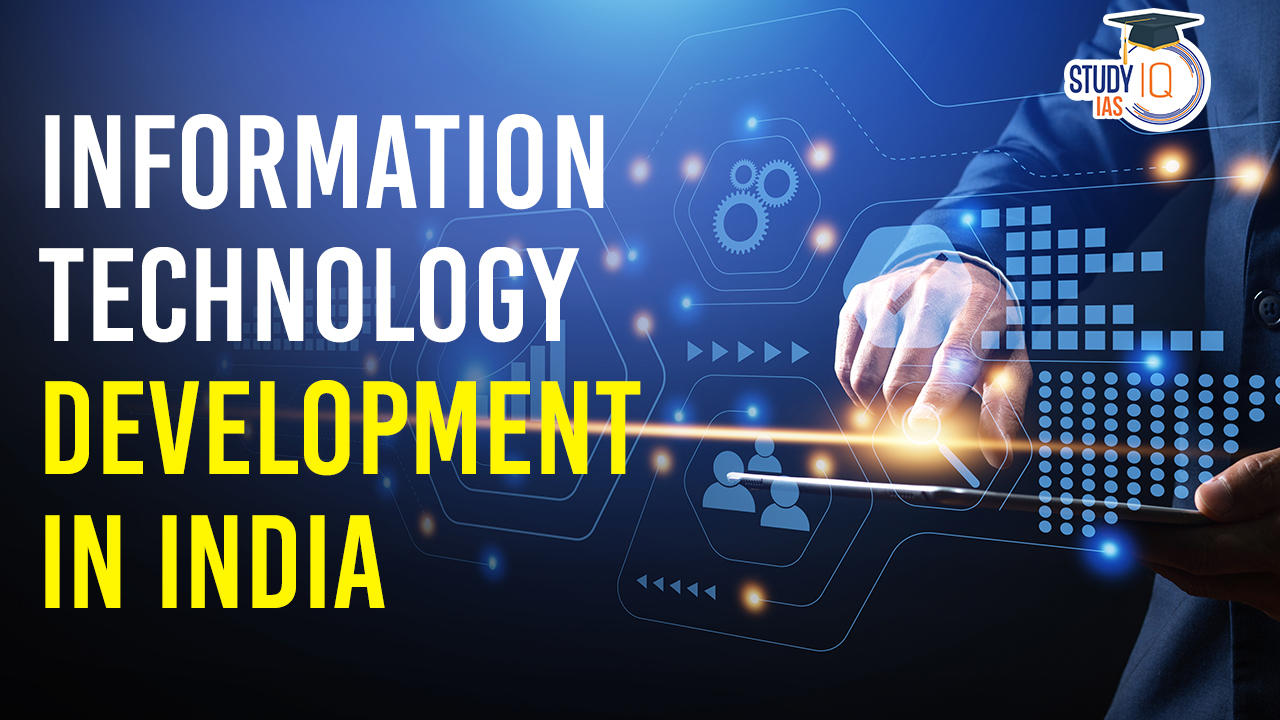Table of Contents
Information Technology (IT) development in India has been a significant and transformative journey that has spanned several decades. India has emerged as one of the world’s leading IT hubs, contributing significantly to the global IT industry.
What is Information Technology (IT)?
Information Technology (IT) involves computers, software, networks, and technology for storing, processing, securing, and managing information. It includes hardware, software, networking, security, databases, cloud computing, programming, and emerging technologies, facilitating businesses, communication, and data-driven decision-making. IT is essential for modern life and encompasses support, management, and innovation in technology.
Information Technology (IT) development in India Current Status
The information technology (IT) industry in India has been a major contributor to the country’s GDP and public welfare. In FY22, the IT industry accounted for 7.4% of India’s GDP, and it is expected to contribute 10% to India’s GDP by 2025. The IT and BPM industries’ revenue is estimated at US$ 245 billion in FY 2023.
The Indian IT industry has grown rapidly with an exponential growth rate after the economic reform of 1991-92. Indian IT companies have set up thousands of centers within India and around 80 countries across the world.
The India ICT Market size was estimated at USD 273.50 billion in the current year and is expected to reach USD 421.59 billion in five years, registering a CAGR of 9.04% during the forecast period.
We’re now on WhatsApp. Click to Join
Information Technology Development in India
India’s Information Technology (IT) development journey is a remarkable success story. The establishment of prestigious institutions like the Indian Institutes of Technology (IITs) and Indian Institutes of Management (IIMs) in the 1950s and 1960s provided the groundwork for excellence in technology and management. The 1980s saw the Indian government’s policy initiatives, including Export Promotion Zones (EPZs), which incentivized the software and IT services industry’s growth. The 1990s witnessed the “Indian IT revolution” with companies like TCS, Infosys, Wipro, and HCL rising to global prominence. India’s cost-effective, skilled workforce, proficiency in English, and robust educational institutions attracted multinational corporations to outsource IT services.
The Y2K bug scare in the late 1990s further accelerated the industry’s growth, leading to the outsourcing of various IT services, and making India a global outsourcing hub. Substantial investments were made in IT parks and infrastructure, including Electronic City and HITEC City, and the education system produced a vast talent pool. Indian professionals working abroad also contributed to the industry’s development.
The IT sector became a global leader in software development, application maintenance, IT consulting, and business process outsourcing, serving clients worldwide. The 21st century witnessed the emergence of numerous IT startups, particularly in e-commerce, fintech, artificial intelligence, and data analytics, attracting significant investments and disrupting traditional industries.
The government’s initiatives such as “Make in India,” “Digital India,” and “Startup India” aimed to promote entrepreneurship and technology innovation. Indian IT companies gained international recognition and some were listed on major global stock exchanges. While the industry has made significant strides, it also faces challenges, including intensifying competition, evolving global economic dynamics, and rapid technological changes. Despite these challenges, the Indian IT industry remains adaptable and innovative, ensuring it stays competitive on the global stage.
| Decades | Key Milestones in Indian IT Development |
| 1950s-1960s | · Establishment of IITs and IIMs, providing technical and managerial expertise. |
| 1980s | · Introduction of policies to promote the software and IT services industry, including EPZs with tax incentives. |
| 1990s | · Emergence of the Indian IT revolution with companies like TCS, Infosys, Wipro, and HCL leading the global IT services market.
· Y2K bug scare leads to a surge in IT demand. · Outsourcing of IT services to India becomes common. |
| 2000s | · Development of IT parks and infrastructure, including Electronic City and HITEC City.
· Expansion of IT education and a growing talent pool. · Indian IT companies serve global clients. |
| 2010s | · Rise of IT startups in areas like e-commerce, fintech, and artificial intelligence.
· Introduction of government initiatives like “Make in India” and “Digital India.” |
| Ongoing | · Indian IT industry faces competition and evolving technologies, continuing to innovate and adapt. |
Major achievements of India in Information Technology (IT)
| Major achievements of India in Information Technology (IT) | |
| Services | India is a leading provider of IT services to global companies. Companies like TCS, Infosys, and Wipro are among the world’s largest IT service providers, offering software development, system integration, and IT consulting. |
| IT Outsourcing | India is a major destination for IT outsourcing, with global giants like Microsoft, IBM, and Accenture establishing development and service centers in India. For instance, Microsoft’s Hyderabad center is one of its largest outside the US. |
| IT Startups | India boasts a vibrant IT startup ecosystem, with companies like Flipkart, Ola, Paytm, and Zomato gaining global recognition. Paytm, a digital payment platform, is a prime example of India’s successful IT startups. |
| Mobile App Development | India has become a hub for mobile app development, with companies and startups creating innovative apps. Practo, for instance, offers online doctor consultations, appointments, and medical records through its mobile app. |
| IT Education and Training | India has a large pool of skilled IT professionals, with prestigious institutions like the Indian Institutes of Technology (IITs) offering top-notch IT education and producing sought-after IT professionals worldwide. |
Major Schemes Related to Information Technology (IT) Sector
| Initiative | Description |
| PLI Scheme | Launched in 2021 to boost domestic manufacturing, investments, and exports in the telecom and networking products with an allocation of ₹12,195 Crores over a 5-year period. |
| Digital India | Launched in 2015 to transform India into a digitally empowered society and knowledge economy, encompassing e-governance, broadband connectivity, digital literacy, and infrastructure projects. |
| National Cyber Security Policy, 2013 | Aims to create a safe and resilient cyberspace for citizens, businesses, and the Government with a focus on cybersecurity. |
| Skill India | Initiated in 2015 to provide vocational training and skill development for India’s youth, enhancing their employability in various industries, including IT. |
| Reskilling Revolution initiative | Announced by the World Economic Forum to reach over 350 million people with improved skills, jobs, and education, involving Indian IT companies in reskilling efforts. |
| Atal Innovation Mission | Launched in 2016 to promote innovation and entrepreneurship in India’s IT sector, offering programs like Atal Tinkering Labs, Atal Incubation Centers, and Atal New India Challenges. |
Information Technology (IT) Applications in India
Information Technology (IT) applications in India have had a profound impact on various sectors, transforming the way businesses, government, and individuals operate. Here are some key applications of IT in India:
- E-Government Services: IT is widely used for delivering government services to citizens. Initiatives like “Digital India” have digitized various administrative processes, making it easier for people to access government services and information.
- Digital Payments: India has witnessed a significant shift towards digital payments, with mobile wallets, UPI (Unified Payments Interface), and online banking services becoming popular. The demonetization drive in 2016 further accelerated the adoption of digital payment methods.
- E-Commerce: E-commerce platforms like Flipkart, Amazon, and Snapdeal have transformed the retail landscape in India. Consumers can now shop for a wide range of products online, contributing to the growth of online businesses.
- Telemedicine: The IT sector has played a pivotal role in the growth of telemedicine in India. Mobile apps and online platforms allow patients to consult with doctors remotely, which became particularly important during the COVID-19 pandemic.
- Education and E-Learning: IT has revolutionized the education sector through e-learning platforms and online courses. EdTech companies like Byju’s and Coursera have made quality education more accessible to students across the country.
- Aadhar: India’s biometric-based identification system, Aadhar, is a prime example of IT integration into identity verification and social welfare distribution.
- Agriculture: IT applications are increasingly being used in agriculture for weather forecasting, crop management, and market access. Farmers can access valuable information through mobile apps.
- Smart Cities: Several Indian cities are implementing smart city initiatives that use IT to improve urban infrastructure, transportation, and citizen services.
- IT in Banking: Banking operations have been digitized, with online banking, mobile banking apps, and ATMs providing convenient and secure banking services to customers.
- Data Analytics: Various sectors, including finance, healthcare, and marketing, are leveraging data analytics to make informed decisions and gain insights from data.
- Manufacturing and Industry 4.0: Manufacturing industries are adopting IT for automation, data-driven decision-making, and predictive maintenance, contributing to Industry 4.0 principles.
- IT in Entertainment: The Indian film and entertainment industry relies on IT for post-production, special effects, and animation, ensuring high-quality content production.
- Startups and Innovation: India has a thriving startup ecosystem, with IT playing a vital role in sectors like fintech, healthtech, and artificial intelligence. These startups are driving innovation and entrepreneurship.
- Cybersecurity: The increasing use of IT has also highlighted the importance of cybersecurity. Companies and organizations invest in IT security to protect their data and systems from cyber threats.
Major Challenges to Indian Information Technology (IT)
The Indian Information Technology (IT) sector, while highly successful and influential, faces several major challenges:
- Skills Shortage and Skill Mismatch: Despite a large pool of IT professionals, there is often a gap between the skills required by the industry and the skills possessed by graduates. The industry needs to adapt quickly to emerging technologies like AI, machine learning, and blockchain.
- Competition from Other Countries: India faces increasing competition from countries like China, the Philippines, and Vietnam, which offer competitive IT services and labor costs.
- Data Privacy and Security: India’s data protection and privacy laws are still evolving and might not meet global standards. This can be a barrier for international clients who are concerned about data security.
- Infrastructure Challenges: Issues like power cuts, inadequate bandwidth, and poor physical connectivity can hinder the sector’s efficiency and growth. Improved infrastructure is vital for maintaining the sector’s competitiveness.
- Protectionist Policies: Protectionist measures in countries like the United States, which is a major market for Indian IT services, can have a significant impact on the sector. Changes in visa policies, for example, can affect the mobility of Indian IT professionals.
- Global Economic Uncertainty: Economic downturns in key markets like the US and Europe can reduce demand for IT services, affecting the growth of Indian IT companies.
- Cybersecurity Threats: The increasing digitization of businesses and services exposes the sector to cybersecurity threats. A breach in data security can erode trust in Indian IT services.
Reforms in the Indian Information Technology (IT) sector
Reforms in the Indian IT sector are essential to address the industry’s current challenges and to sustain its growth and global leadership. Here are some key reforms that can help the Indian IT sector:
- Skill Development and Education: Invest in modernizing and updating the IT education system to align with industry needs. Promote skill development programs, including reskilling the existing workforce in emerging technologies like AI, ML, and cybersecurity.
- Research and Innovation: Encourage and fund research and development initiatives, fostering innovation in IT. Collaborations between academia, government, and industry can drive cutting-edge technological advancements.
- Data Privacy and Cybersecurity Regulations: Implement comprehensive data protection and privacy laws that align with international standards. Enhance cybersecurity measures to protect sensitive data and build trust with global clients.
- Infrastructure Improvement: Address infrastructure challenges, such as power reliability, bandwidth, and physical connectivity. Investing in robust digital infrastructure is crucial to support the industry’s growth.
- Promote Startups: Create a conducive environment for IT startups by simplifying regulatory procedures, providing access to funding, and offering incentives for innovation and entrepreneurship.
- Global Trade Agreements: Negotiate favorable trade agreements with key markets, reducing the impact of protectionist policies. Diversify the client base to minimize dependency on specific regions.
- Environmental Sustainability: Encourage IT companies to adopt eco-friendly and energy-efficient practices. Promote sustainability and green data center initiatives.
- Government Procurement: Promote the use of domestic IT solutions and services in government projects, fostering the growth of indigenous IT companies.
- Digital Literacy: Invest in digital literacy programs to ensure that a larger section of the population is tech-savvy and can contribute to the digital economy.
- Regulatory Compliance: Simplify and streamline regulatory compliance for IT companies operating globally. This includes taxation, intellectual property, and export-import regulations.
- Collaboration with International Bodies: Collaborate with international organizations to align Indian IT standards and practices with global norms, enhancing India’s reputation in the international IT arena.
- Industry Associations: Encourage industry associations and forums to facilitate knowledge sharing, best practices, and advocacy for the sector.
Information Technology (IT) in India UPSC
India’s Information Technology (IT) sector has become a vital part of the global tech landscape, contributing significantly to the country’s GDP. Key milestones include the establishment of prestigious educational institutions in the 1950s, government policies in the 1980s promoting IT growth, and the explosive rise of companies like TCS, Infosys, and Wipro in the 1990s. India’s IT sector is known for its cost-effective, skilled workforce and proficiency in English. The Y2K bug scare and subsequent outsourcing solidified India’s position as a global IT hub. Challenges include skill shortages, global competition, data security concerns, infrastructure issues, and protectionist policies. Reforms are needed in education, infrastructure, and regulations to maintain and enhance the sector’s global standing.


 Project 75I, Background, Key Features an...
Project 75I, Background, Key Features an...
 Artificial General Intelligence, Benefit...
Artificial General Intelligence, Benefit...
 Llama 3, Most Sophisticated LLM AI Model...
Llama 3, Most Sophisticated LLM AI Model...

















